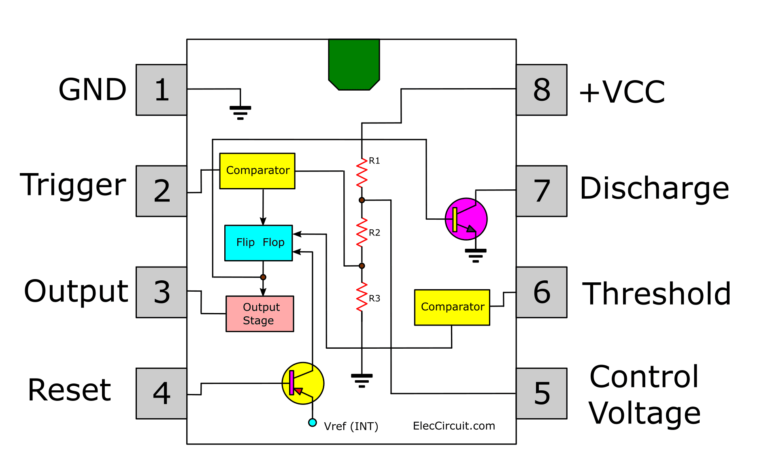
This pin is used to reset the Flip-flop when the voltage applied to it exceeds 2/3Vcc causing the output to switch from “HIGH” to “LOW” state. – Threshold, The positive input to comparator No 2. When not used it is connected to ground via a 10nF capacitor to eliminate any noise. By applying a voltage to this pin the width of the output signal can be varied independently of the RC timing network. – Control Voltage, This pin controls the timing of the 555 by overriding the 2/3Vcc level of the voltage divider network. This is an active-low input and is generally connected to a logic “1” level when not used to prevent any unwanted resetting of the output. – Reset, This pin is used to “reset” the internal Flip-flop controlling the state of the output, pin 3. – Output, The output pin can drive any TTL circuit and is capable of sourcing or sinking up to 200mA of current at an output voltage equal to approximately Vcc – 1.5V so small speakers, LEDs or motors can be connected directly to the output. A negative pulse on this pin “sets” the internal Flip-flop when the voltage drops below 1/3Vcc causing the output to switch from a “LOW” to a “HIGH” state. – Trigger, The negative input to comparator No 1. – Ground, The ground pin connects the 555 timer to the negative (0v) supply rail. The 555 timer chip is extremely robust and stable 8-pin device that can be operated either as a very accurate Monostable, Bistable or Astable Multivibrator to produce a variety of applications such as one-shot or delay timers, pulse generation, LED and lamp flashers, alarms and tone generation, logic clocks, frequency division, power supplies and converters etc, in fact any circuit that requires some form of time control as the list is endless.

The 555 timer IC is a very cheap, popular and useful precision timing device which can act as either a simple timer to generate single pulses or long time delays, or as a relaxation oscillator producing a string of stabilised waveforms of varying duty cycles from 50 to 100%.

The basic 555 timer gets its name from the fact that there are three internally connected 5kΩ resistors which it uses to generate the two comparators reference voltages. One such device that has been around since the early days of IC’s and has itself become something of an industry “standard” is the 555 Timer Oscillator which is more commonly called the “555 Timer”. But there are also dedicated IC’s such as the 555 timer especially designed to accurately produce the required output waveform with the addition of just a few extra timing components. We have seen that Multivibrators and CMOS Oscillators can be easily constructed from discrete components to produce relaxation oscillators for generating basic square wave output waveforms.


 0 kommentar(er)
0 kommentar(er)
